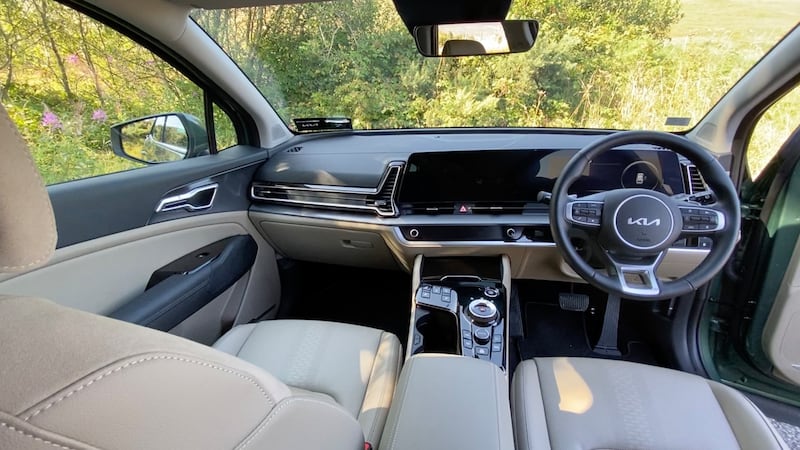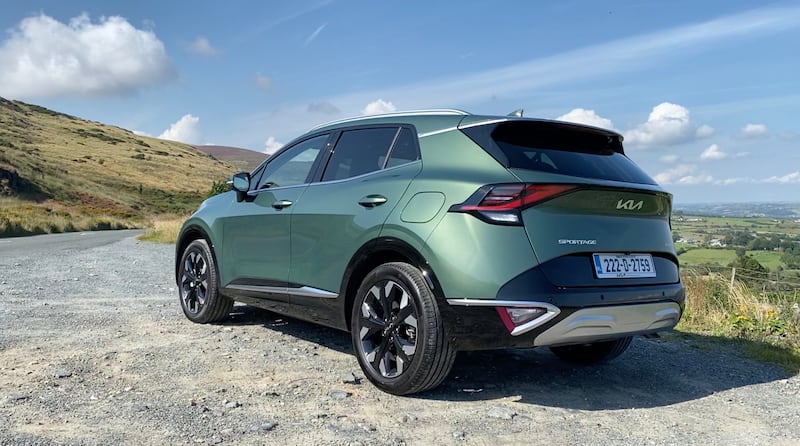Yes, it’s green. Very green. Sorry to be the bearer of bad puns (not sorry at all, really) but whoever chose the colour scheme for this particular Kia Sportage test car deserves some kind of medal. The shade is officially known as “Experience Green” if you go and check the Kia brochure, but I shall refer to it as 1960s Aston Martin Green because — well, just go and Google some images and you’ll see why.
The internal Kia genius who picked the green has paired it with pale tan leather-and-suede seats for the ultimate 1960s combo on this most modern of cars — a Korean family SUV with a plug-in hybrid power-train. Honestly, a car with these shades applied really ought to come with some kind of a straight-six and a ticket for the boat-train to Calais, but alas it’s 2022 and not 1962.
Not only am I showing my age, I’m also showing myself up as someone who’s supposed to be coolly objective about cars, but getting distracted by colour swatches. As a professional reviewer, I’m technically supposed to obsess over the technical details of a car, not worry about whether the shade matches my shirt but here we are — as someone once said; we eat with our eyes.
Finally, I can see what a handsome car the current Sportage is, though. The previous two that I’d driven — a 1.6 diesel and a non-plug-in hybrid — were plain black, which made the shape look a little dumpy and doughy (not that I can talk ...). Resplendent in the 1960s Aston Martin Green, the Sportage looks far sharper, and that big gaping grille with its arrowhead lights looks far more interesting.
Inside, it’s arguably the best car in its class. Certainly the cabin in this “K3″ specification (and you can’t have the plug-in hybrid engine in any other spec right now) looks really impressive with its sweeping, paired-up screens for the instruments and infotainment, and the little strip of touchscreen in the centre of the dash, which switcheroos from climate control to navigation shortcuts at the brush of a fingertip, is still the best solution I’ve yet seen to the conflicting demands of touchscreen tech and simplicity of driving controls.

Away from the tech, Kia gets the basics right too. The seats are very comfortable in the front, although at first you do feel as if your back is sinking a little too deeply into the backrest (you get used to it) while there’s ample space for legs and heads in the rear, and just about enough width for a centre-rear seat passenger to get tolerably comfy.
There’s oodles of storage space on the centre console, big bins in the doors, and I still love the way that Kia puts the rear-seat USB sockets half way up the front seat backs, rather than burying them down by people’s feet. I also love the sleek headrest design that incorporates a coat-hanger. Kia is fast becoming a rival for Skoda and Volvo when it comes to thoughtfully-designed interiors.
You can see imperiously out, too as the twin-screen dash is set quite low, affording you a panoramic view out the front. A shame that the angled rear pillar cuts off rear visibility a bit, but the sharp reversing camera compensates.
To drive, the Sportage is ... fine. Arguably slightly better than the class average for family-sized SUVS, but behind the likes of the Ford Kuga and the Mazda CX-5 when it comes to sharpness of steering and responsiveness of chassis. Compared to its distant stablemate, the Hyundai Tucson, it’s arguably a little more playful, but not by a huge amount. It is, though, very good is disguising the extra heft of its plug-in hybrid battery — you’re only occasionally aware that the kerb weight is chunkier than that of the petrol or diesel models.
Which brings us to the slightly thorny issue of the that plug-in hybrid system. A few weeks back, we drove the new Kia Niro PHEV, which is about as good a plug-in hybrid as you can get. It combines a lengthy electric range on a full charge with exceptionally good long-haul fuel economy when you need to take it on a longer journey. The Sportage only manages one of these things ...

Fully charge the battery, and Kia says you can go for 70km on one charge, almost a match for the Toyota RAV4 PHEV. That seems like a fairly realistic claim — 50km is easy-peasy, and getting past 60km seems to take only a modicum of care and attention, especially on the sorts of urban routes to which the system is best suited. Head out on the motorway, though, and things start to fall apart just a bit.
The Sportage cruises well, with just a touch too much tyre noise but otherwise good refinement. What it’s not good at is avoiding dipping into the depths of its petrol tank. On a two-hour motorway run, we recorded fuel economy of 7.1 litres per 100km, which is frankly not that great. A comparable Peugeot 3008 PHEV returned 6.5 litres per 100km on the same route. A Toyota RAV4 PHEV seems to return 5.4 litres per 100km no matter how abusive is your relationship with the accelerator pedal. The Kia is just too darned thirsty.
Of course, that has to be placed in the context that the combined power of its petrol and electric motive sources equals a rousing 265hp, and it has four-wheel drive. Sadly, that power doesn’t really come out to play. Hammer the throttle hard and the Sportage PHEV will sprint to 100km/jh in 8.2secs, which is 0.2secs slower than the standard petrol model. A Toyota RAV4 PHEV is 2.2secs further up the road.
It’s a bit of a shame. Just as someone in Kia gave a Sportage the sort of colour scheme to make me fall in love with it, the power-train lets it down. It’s not a bad car by any means, but it’s behind the curve when it comes to all-round PHEV performance. The green paint and tan leather might have tickled my 1960s fancy, but they failed to sway me in the end. Mostly. Almost. Well, maybe a little. A bit.
Lowdown: Kia Sportage PHEV K3
Power: 1.6 litre turbocharged petrol engine + 91hp electric motor developing 265hp and 350Nm of torque, driving a six-speed automatic transmission with four-wheel drive
CO2 emissions (annual motor tax) 25g/km (€140)
Fuel consumption: 1.1l/100km
Electric range: 70km
Electric consumption: 16.9kWh/100km
0-100km/h: 8.2sec
Price: €46,000 as tested, Sportage starts from €35,500
Our rating: 2/5
Verdict: Looks brilliant in this colour, but needs better long-range economy to compete with Toyota





